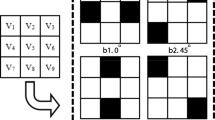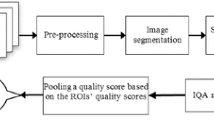Abstract
When individuals view an image, they form an opinion by considering only some parts of the image, which are defined as regions of interest. Based on this hypothesis, in this paper, a local gray-scale fluctuation measurement is used to select image patches with rich structural information and texture that can attract human visual perception. First, a gray-scale fluctuation map (GFM) is calculated based on a specific primitive. The pixel values in the GFM reflect the gray-scale fluctuation level of the pixel in the same location in the corresponding image. Second, the patches are selected via the gray-scale fluctuation conditions in the GFM. Third, existing image quality assessment (IQA) methods are used to measure the quality of each patch. Additionally, the quality assessment results of each patch are combined as the quality score of the entire image. The experimental results on five open databases demonstrate that the proposed method has a positive effect on IQA for existing methods. Additionally, the proposed method can improve the prediction accuracy of the quality assessment of diversely distorted types.









Similar content being viewed by others
References
Alaei A, Raveaux R, Conte D (2017) Image quality assessment based on regions of interest. SIViP 11(4):673–680
Bhateja V, Kalsi A, Srivastava A (2015) Image similarity metric (ISIM): a reduced reference image quality assessment approach. CSI Transactions on ICT 3(1):1–11
Damera-Venkata N, Kite T D, Geisler W S. (2000) et al. Image quality assessment based on a degradation model. IEEE Trans Image Process, 9(4):636–650
Ji H, Liu C (2008) Motion blur identification from image gradients. Computer Vision and Pattern Recognition, 2008. CVPR 2008. IEEE Conference on. IEEE, 1–8
Larson EC, Chandler DM (2010) Most apparent distortion: full-reference image quality assessment and the role of strategy. J Electron Imaging 19(1):011006
Liu GH, Yang JY (2008) Image retrieval based on the texton co-occurrence matrix. Pattern Recogn 41(12):3521–3527
Liu Y, Zhang X, Cui J, et al (2010) Visual analysis of child-adult interactive behaviors in video sequences. International Conference on Virtual Systems and Multimedia. IEEE, 26–33
Liu A, Lin W, Narwaria M (2012) Image quality assessment based on gradient similarity. IEEE Trans Image Process 21(4):1500
Liu D, Xu Y, Quan Y et al (2014) Reduced reference image quality assessment using regularity of phase congruency. Signal Process Image Commun 29(8):844–855
Liu Y, Nie L, Han L, et al (2015) Action2Activity: recognizing complex activities from sensor data. International Conference on Artificial Intelligence. AAAI Press, 1617–1623
Liu Y, Nie L, Liu L et al (2016) From action to activity: sensor-based activity recognition. Neurocomputing 181:108–115
Liu L, Cheng L, Liu Y, et al (2016) Recognizing complex activities by a probabilistic interval-based model. Thirtieth AAAI Conference on Artificial Intelligence. AAAI Press, 1266–1272
Lu Y, Wei Y, Liu L et al (2017) Towards unsupervised physical activity recognition using smartphone accelerometers. Multimed Tools Appl 76(8):10701–10719
Mitsa T, Varkur K L (1993) Evaluation of contrast sensitivity functions for the formulation of quality measures incorporated in halftoning algorithms. IEEE International Conference on Acoustics, Speech, and Signal Processing IEEE, 5: 301–304
Moorthy AK, Bovik AC (2011) Blind image quality assessment: from natural scene statistics to perceptual quality. IEEE Trans Image Process A Publ IEEE Signal Process Soc 20(12):3350–3364
Ponomarenko N, Lukin V, Zelensky A et al (2004) TID2008 - a database for evaluation of full-reference visual quality assessment metrics. Adv Mod Radioelectron 10:30–45
Ponomarenko N, Jin L, Ieremeiev O et al (2015) Image database TID2013: peculiarities, results and perspectives. Signal Process Image Commun 30:57–77
Saad MA, Bovik AC, Charrier C (2012) Blind image quality assessment: a natural scene statistics approach in the DCT domain. IEEE Trans Image Process A Publ IEEE Signal Process Soc 21(8):3339–3352
Sheikh HR, Bovik AC (2006) Image information and visual quality. IEEE Trans Image Process A Publ IEEE Signal Process Soc 15(2):430–444
Sheikh HR, Bovik AC, Veciana GD (2005) An information fidelity criterion for image quality assessment using natural scene statistics. IEEE Trans Image Process 14(12):2117–2128
Sheikh HR, Sabir MF, Bovik AC (2006) A statistical evaluation of recent full reference image quality assessment algorithms. IEEE Trans Image Process A Publ IEEE Signal Process Soc 15(11):3440–3451
Sun T, Ding S, Chen W et al (2014) No-reference image quality assessment based on gradient histogram response. Comput Electr Eng 54:330–344
Wang Z, Bovik AC (2002) A universal image quality index. IEEE Signal Process Lett 9(3):81–84
Wang Z, Bovik AC (2009) Mean squared error: love it or leave it? A new look at signal Fidelity measures. IEEE Signal Process Mag 26(1):98–117
Wang Z, Bovik AC, Sheikh HR et al (2004) Image quality assessment: from error visibility to structural similarity. IEEE Trans Image Process A Publ IEEE Signal Process Soc 13(4):600–612
Wang Z, Simoncelli E P, Bovik A C. (2004) Multiscale structural similarity for image quality assessment. Signals, systems and computers, 2004. Conference Record of the Thirty-Seventh Asilomar Conference on. IEEE, 398–1402 Vol.2
Wu J, Qi F, Shi G (2012) Self-similarity based structural regularity for just noticeable difference estimation. J Vis Commun Image Represent 23(6):845–852
Xie X, Livermore C (2016) A pivot-hinged, multilayer SU-8 micro motion amplifier assembled by a self-aligned approach. IEEE, International Conference on MICRO Electro Mechanical Systems. IEEE, 75–78
Xie X, Livermore C (2017) Passively self-aligned assembly of compact barrel hinges for high-performance, out-of-plane mems actuators. IEEE, International Conference on MICRO Electro Mechanical Systems. IEEE
Xie X, Zaitsev Y, Velásquezgarcía LF et al (2014a) Scalable, MEMS-enabled, vibrational tactile actuators for high resolution tactile displays. J Micromech Microeng 24(12):125014
Xie X, Zaitsev Y, Velasquezgarcía LF, Teller SJ, Livermore C (2014b) Compact, scalable, high-resolution, MEMS-enabled tactile displays. In: Proc. of solid-state sensors, actuators, and microsystems workshop, pp 127–30
Yang X (2014) Completely blind image quality assessment based on gray-scale fluctuations. International Conference on Digital Image Processing 915916
Yang X, Sun Q, Wang T (2016) Image quality assessment via spatial structural analysis. Comput Electr Eng. https://doi.org/10.1016/j.compeleceng.2016.08.014
Yuan Y, Guo Q, Image LX (2015) Quality assessment: a sparse learning way. Neurocomputing 159(1):227–241
Zhang L, Zhang L, Mou X et al (2011) FSIM: a feature similarity index for image quality assessment. IEEE Trans Image Process 20(8):2378–2386
Acknowledgments
This paper is supported by the National Science Foundation of China (Grant No. 61673220).
Author information
Authors and Affiliations
Contributions
Conceived and designed the experiments: Xichen Yang. Performed the experiments: Xichen Yang. Analyzed the data: Xichen yang, Quansen Sun. Wrote and reviewed the paper: Xichen yang, Quansen Sun, Tianshu Wang. Approved the final version of the paper: Xichen yang, Quansen Sun, Tianshu Wang.
Corresponding author
Ethics declarations
Competing interests
The authors have declared that there is no competing interests exist.
Rights and permissions
About this article
Cite this article
Yang, X., Sun, Q. & Wang, T. Image quality assessment improvement via local gray-scale fluctuation measurement. Multimed Tools Appl 77, 24185–24202 (2018). https://doi.org/10.1007/s11042-018-5740-z
Received:
Revised:
Accepted:
Published:
Issue Date:
DOI: https://doi.org/10.1007/s11042-018-5740-z




